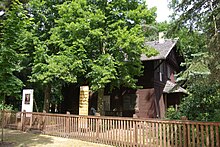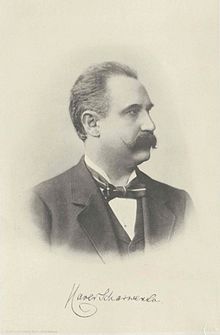Xaver Scharwenka
Theophil Franz Xaver Scharwenka (born January 6, 1850 in Samter near Posen ; died December 8, 1924 in Berlin ) was a German composer , pianist and music teacher of Polish-Czech origin.
He is the brother of the composer and music teacher Philipp Scharwenka and the uncle of the composer and organist Walter Scharwenka .
Life
Scharwenka received his first musical instruction in Poznan, where he also graduated from high school. In 1865 he came to Berlin to study piano with Theodor Kullak , theory and composition with Richard Wüerst and Heinrich Dorn at the Neue Akademie der Tonkunst . After completing his training, he worked there from 1868 to 1874 as a piano teacher. His career as a pianist, conductor and composer began with a triple debut in 1869 at the Sing-Akademie zu Berlin . The Breitkopf & Härtel publishing house immediately printed Scharwenka's Piano Trio, Op. 1 , his Violin Sonata, Op. 2, and 5 Polish Dances, Op. 3 for piano. In 1877 he composed the Piano Concerto No. 1, Op. 32, one of his most important and most highly regarded works, which paved the way for him to the musical centers of Europe and North America. This concert is dedicated to Franz Liszt , who had been promoting Scharwenka since the first Polish Dance appeared in 1870. Scharwenka also maintained friendly contacts with Johannes Brahms , Ferdinand Hiller and Hugo Kaun . He formed a piano trio with Gustav Hollaender (violin) and Heinrich Grünfeld (cello) and gave chamber music evenings at the Berlin Singakademie from 1871 to 1881 .


In Berlin he opened the chamber music-oriented “subscription concerts” in 1879 and an orchestral concert series in 1886 in which he distinguished himself as a conductor. Together with his brother Philipp Scharwenka, he founded the Scharwenka Conservatory in 1881, which was merged with Karl Klindworth's piano school to form the Klindworth Scharwenka Conservatory in 1893 . Between 1880 and 1886 he edited the complete works of Chopin and Schumann , and later also Mendelssohn . In addition to his appointment as court pianist, he also increasingly turned to composition. From 1891 Scharwenka moved to New York for seven years and founded his second conservatory there, the Scharwenka Conservatory of Music . After numerous concert tours through the USA, he returned to Germany in 1898 and was appointed to the Senate of the Royal Prussian Academy of the Arts in Berlin in 1901 . He made friends with Max Bruch , gave concerts with Ferruccio Busoni and performed his piano concertos under Gustav Mahler and Arthur Nikisch . On March 7, 1905, he recorded 14 piano pieces for the Welte-Mignon reproduction piano , including two of his own compositions.
In 1914 he opened another master school with a piano teacher seminar with Walter Petzet . His students included José Vianna da Motta , Kurt Schubert and Gustav Ernest . With numerous courtly awards as well as an honorary doctorate from the University of Tennessee (1896), he also appeared in music politics as chairman of the Music Education Association and the Association of German Concert Artists .
In 1910/12 he had a villa built in wood frame construction as a summer house (his "muse hut") in Bad Saarow , which has been a listed building since 2005 as a Scharwenka House and subsequently by the Scharwenka Foundation and the Association of the Bad Saarow Health Resort has been gradually refurbished and restored.
He found his final resting place in a family grave in Dept. P-004-008 / 009 on the old St-Matthäus-Friedhof in the Berlin district of Tempelhof-Schöneberg . Since 2014, according to the Senate resolution, it is no longer the “ Land of Berlin Grave of Honor ”. It was then restored and cleaned by the Förderverein EFEU eV - also with donations from the Scharwenka Foundation.
meaning
His diverse talents made Scharwenka one of the most successful artistic personalities of the late 19th century. Even during his lifetime he was one of the most famous piano virtuosos in the world. Eduard Hanslick described him in concerts, composers and virtuosos of the last fifteen years, 1870–1885 (Berlin 1886), as “a very excellent pianist, dazzling without charlatanry”. He achieved worldwide renown also through his extraordinary pedagogical skills. During his teaching activities he trained thousands of students from various countries and wrote several important music pedagogical writings. Scharwenka established his fame as a composer with the Polish National Dances op. 3 ; his symphony in C minor and the opera Mataswintha , on the other hand, only achieved notable successes. Scharwenka's other compositional output includes piano concertos , piano trios and piano quartets, sonatas and dances , but did not go beyond the conservative Mendelssohn-Schumann successor.
Works (selection)
Vocal music
- Shuvoh for bass, mixed choir and organ (1890s)
- Kaiserkantata for mixed choir, solo and organ (1900)
- 4 songs for mezzo-soprano and piano op.10 (1873)
- 3 songs for mezzo-soprano and piano op.15 (1874)
- 8 chants for medium voice and piano op.88 (1915)
- 2 chants for male choir, op.79 (1895)
Stage works
- Mataswintha (text: Felix Dahn), opera in 3 acts, (1888–1892; premiered 1896 Weimar)
- The mayor of Paris (text: Lope de Vega), comic opera, fragment (1897–1898)
Instrumental music
-
Orchestral works and concerts
- Overture in C minor (1869)
- Symphony in E flat major (around 1875), lost
- 1st Piano Concerto in B flat minor, Op. 32 (1869–1873)
- 2nd Piano Concerto in C minor, Op. 56 (1879–1881)
- Symphony in C minor, Op. 60 (1882, first recording in 2003)
- 3rd Piano Concerto in C sharp minor, Op. 80 (1889)
- 4th Piano Concerto in F minor, Op. 82 (1907/08)
-
Chamber music
- Piano trio in F sharp major op.1 (1868)
- Sonata in D minor for piano and violin op.2 (1869)
- String Quartet in G minor (before 1875)
- Piano quintet in F major op.37 (1876/1877)
- 2nd Piano Trio in A minor, Op. 45 (1877–1879)
- Sonata for piano and violoncello in E minor, Op. 46 (1877)
- Serenade in G major for piano and violin op.70
-
Piano music
- Five Polish National Dances op.3 (1870)
- Scherzo in G major op.4
- Tales at the piano op.5
- 1st Sonata in C sharp minor, Op. 6 (1871)
- Barcarole in D major op.14 (1874)
- Impromptu in D major op.17
- Valse-Caprice in A major op.31 (1875/76)
- Romanzero op.33 (1876)
- 2nd Sonata in E flat major op.36 (1876/77)
- Theme and Variations op.48 (1879)
- Sonatina in E minor op.52
- Four Polish National Dances op.58 (1879)
- Variations on an own theme in C major op.83 (1913)
Adaptations of other works
- Frédéric Chopin , Andante and Polonaise op.22 (1902)
- Johann Nepomuk Hummel , 4th piano concerto op.89 (1902)
Teaching works and writings
- Contributions to finger formation op.77 , Leipzig 1903
- Studies in Octave Playing, Op. 78, Leipzig 1904
- Method of playing the piano , Leipzig 1907
- Master School of the Piano , Leipzig
- Sounds from my life: memories of a musician , Leipzig 1922
- Handbooks of Music Teaching , Leipzig
Autobiography
- Xaver Scharwenka: Sounds from my life. Memories of a musician . Leipzig, Koehler, 1922
- English-language edition: Xaver Scharwenka, sounds from my life, reminiscences of a musician . Lanham, Md., Scarecrow Press, 2007. ISBN 0-8108-5669-7
literature
- Matthias Schneider-Dominco: Scharwenka, Xaver. In: Ludwig Finscher (Hrsg.): The music in past and present . Second edition, personal section, volume 14 (Riccati - Schönstein). Bärenreiter / Metzler, Kassel et al. 2005, ISBN 3-7618-1134-9 , Sp. 1187–1189
- Matthias Schneider-Dominco: "Xaver Scharwenka - Catalog raisonné" Xaver Scharwenka (1850–1924). Catalog of works (ScharWV), Hainholz Verlag, Göttingen / Kassel 2003
- Matthias Schneider-Dominco: Xaver Scharwenka , in: Ludwig Finscher (Ed.), MGG , Vol. 14, Kassel 2005
- Matthias Wiegandt: Scharwenka, Theophil Franz Xaver. In: New German Biography (NDB). Volume 22, Duncker & Humblot, Berlin 2005, ISBN 3-428-11203-2 , p. 585 f. ( Digitized version ).
- Eberhard Geiger: Who was Xaver Scharwenka? Published by the Förderverein Kurort Bad Saarow eV, Bad Saarow 2009.
Documents
Letters from Xaver Scharwenka are in the holdings of the Leipzig music publisher CFPeters in the Leipzig State Archives . Letters and notes from Xaver Scharwenka can be found in the archive of the Scharwenka Foundation (www.scharwenka-stiftung.de)
Web links
- Works by and about Xaver Scharwenka in the German Digital Library
- Works by and about Xaver Scharwenka in the catalog of the German National Library
- Scharwenka, Xaver . In: East German Biography (Kulturportal West-Ost)
- Complete catalog raisonné on klassika.info
- Xaver Scharwenka ( Memento from November 29, 2004 in the Internet Archive ) (archived at Internet Archive )
- Sheet music and audio files by Xaver Scharwenka in the International Music Score Library Project
- Scharwenka Foundation Bad Saarow
- Franz Xaver Scharwenka - composer from Posen (2002) by Michael Wittmann
Individual evidence
- ^ Sybille Gramlich: Bad Saarow - two artist houses in the Moorstrasse. ( Memento of the original from June 29, 2016 in the Internet Archive ) Info: The archive link was automatically inserted and not yet checked. Please check the original and archive link according to the instructions and then remove this notice. Brandenburg State Office for Monument Preservation and State Archaeological Museum , 23 May 2006.
- ↑ Scharwenka Foundation: Foundation brochure, Bad Saarow 2008, p. 7f.
- ↑ Scharwenka Foundation: The Scharwenka House in Bad Saarow. April 23, 2010.
- ↑ jpc.de
- ↑ www.sterlingcd.com
| personal data | |
|---|---|
| SURNAME | Scharwenka, Xaver |
| ALTERNATIVE NAMES | Scharwenka, Theophil Franz Xaver (full name) |
| BRIEF DESCRIPTION | German composer, pianist and music teacher of Polish-Czech origin |
| DATE OF BIRTH | January 6, 1850 |
| PLACE OF BIRTH | Samter near Poznan |
| DATE OF DEATH | December 8, 1924 |
| Place of death | Berlin |

